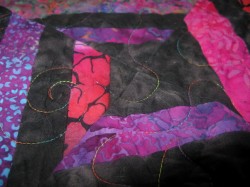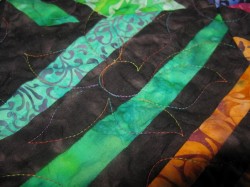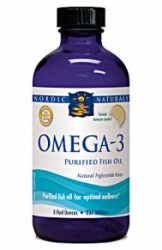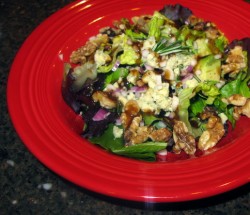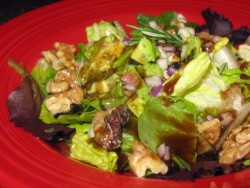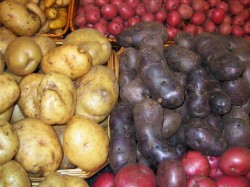Morganna’s Quilt II–The Finished Photos
I promised that I would take some photos of Morganna’s quilt after she came home for Spring Break, so here they are.
This one shows the overall effect, including the backing fabric, which is another batik that has nearly all of the colors of the quilt included in it, except for the black, indigo, clear blue and clear purples. But it looks great with the other fabrics, as you can see.
The thread we chose is multi-colored so in some parts of the quilt, it shows up readily, while in others, it fades into the background, so the quilting is either obvious or subtle, depending on what part of the quilt you are looking at. From the back, it is very subtle.
Here are close-ups so you can see the funky continual line quilting that Susan and I came up with for her to do. Lots of swirlies and spirals and waves with leaves and flowers worked into the design.
These designs thematically echo the flowery, swirly, spirally designs of the various batiks on the quilt top.
As much as I love Susan’s quilting, I want to do more of my own quilting work, because when I free motion on smaller projects, I can do some really pretty stuff. But on large quilts, I am not there yet.
That is, not yet.
My dear friend Amy, who is living between two homes, one here in Athens and one in Stow, Ohio. Once she finishes her PhD in Geography at Kent State, she will be moving back here, but until then, her quilting frame is going to have to be put into storage.
Well, she had me come to her place and give it a go–and she is not kidding–quilting on it is just like drawing. Even without a stitch regulator to keep the stitch length perfectly even, the thing is the next best thing to a long-arm machine. I think that after a couple of evenings’ practice, I should be able to quilt beautiful free-motion continual line-designs.
And bless her, she offered to let me baby sit it for her while she moves–rather than put it all into storage.
So, needless to say, I am cleaning out a place to put it–it is a large bit of equipment–so I can maybe quilt the baby quilt I am making for a new cousin–Claire Marie–all on my own!
Weekend Kat Blogging: Speech Delay and Fish Oil Supplements
I have wonderful news: last night, at about two in the morning after Kat woke up from a bad dream, and insisted she was hungry (she wakes up hungry in the middle of the night during a growth spurt), we brought her downstairs to make her a scrambled egg.
She saw her big sister, Morganna, who was still up after a night shift at the restaurant, and squealed with delight, ran to her and hugged her tightly, insisting that Morganna hold her. She ate her snack on Morganna’s lap, and then the two of them started to play.
Since neither of them had seen each other much for the past couple of months (Morganna is on spring break from OU), I figured, to heck with bedtime and let them go. While they were galumphing, chasing and tickling, Kat said Morganna’s name, perfectly and clearly, not once, but three times in all of our hearing, much to everyone’s absolute delight.
I even got a little choked up, because Kat has had a hard time with expressive speech. Her receptive speech has always been perfectly fine–she has always understood us, at even a more advanced level than is normal, but she could hardly make any words and would get stuck on one-syllable sounds that stood in for every other word she couldn’t say. She relied on gesture and signs to get her meaning across, and we all had to essentially develop psychic skills to converse with her.
Well, we took her to a really great speech therapist here in town, Kim Hale, and she said that it had to do with Kat’s facial muscle development, which is tied in to her premature birth, and is tied up with her learning to walk so much slower than normal. She couldn’t feel how the shape of her mouth needed to be for the sounds to be produced, so she had trouble making sounds. Kim showed us how to manipulate Kat’s face to help her make proper sounds, and eventually, Kat would do the little manipulations with her own hand to help her mouth move correctly and she started talking, right away.
At this point, she doesn’t even need to do that, and while she is still going to speech therapy, she is on track again, and is picking up words–even complex ones like Morganna’s name, like they were pebbles on the beach. And she is so much happier–as are we.
We were pretty worried about it.
One thing that we also did, is on the advice of her pediatrician, we started supplementing her diet with Nordic Naturals fish oil, which is full of Omega-3 fatty acids. Dr. Wapner said that he likes all of his patients to have it, but he especially wanted her to have it because it can help kids who have speech delays, including kids with Oral Apraxia or Vocal Apraxia.
None of the speech therapists Kat has gone to have thought that she had verbal apraxia, but her expressive speech patterns were similar to kids with this neurological disorder. And as we read the book, The Later Talker: What To Do If Your Child Is Not Talking Yet, by Marilyn Agin MD, Lisa Geng, and Malcolm J. Nicholl, which admittedly does deal primarily with verbal apraxia, we came across some preliminary studies which indicate that fish oil supplements do indeed seem to help kids, often dramatically, with their expressive speech delays.
So, I took it upon myself, upon the advice from Kat’s pediatrician and the advice of the pediatrician who wrote the aforementioned book, to give Kat fish oil supplements. I chose Nordic Naturals, because Dr. Wapner assured me that it didn’t taste bad, and when I brought it home and tried it, he was correct. It was quite refined, and the addition of orange essential oil for flavoring rendered it quite palatable. And, when stirred into Kat’s orange juice–it was nearly undetectable.
I want to say this–even though this is purely anecdotal, and I am certainly not a pediatrician, so am not giving medical advice–within a week of taking daily doses of the fish oil–Kat’s speech improved dramatically. Part of it was getting her to a good therapist who helped show us how to model sounds with Kat by molding her mouth while she spoke, but I am pretty sure that the fatty acids in the fish had something to do with it.
One theory, as stated in The Late Talker, is that kids who don’t have a lot of Omega 3’s naturally in their diets do not produce as much myelin, which is the sheath to neurons and that promote connections in the corpus collosum, which is the membrane between the two hemispheres of the brain. (I am simplifying here, so bear with me.) The myelin sheath also promotes electrical conductivity in the neurons, and is made primarily of fatty acids including the Omega 3 fatty acids. It is thought that deficiency in these Omega 3’s can slow brain development including in areas that involve speech production.
So, that is the deal.
Kat is finally speaking, and in addition to being able to thank great speech therapists, and having Mom home full time along with Dad, I think we can also thank fish oil supplements.
I just wish we lived where there was abundant, fresh, safe to eat fish!
The Foodie-in-Chief and The First Locavore?
These are my new titles for our President and First Lady, and I think they are probably apropos, in addition to being cute.
I find it fascinating how everyone wants to know everything about the Obamas–what they wear, where they send their kids to school, and what they eat, all being included in the exuberant public curiosity that follows their every move. I can understand some of it–after eight years of having a pretty uncharismatic First Family for Americans to look at, the Obamas are most certainly a breath of fresh air. They are a beautiful, young, and friendly couple with two really adorable kids, and of course, they came into office on a wave of hope and promise for a new way of doing things in America.
So is isn’t really surprising that people are focusing on what foods the First Family likes to eat. And, all of the media interest makes sense, because as the many new designs of sleeveless fashion can show us, the Obamas are now role models whom Americans seem ready to embrace and emulate.
When it comes to food, the Obamas seem to have come in favor of home gardening, local food, and sustainable agriculture.
How do I know this?
They are breaking ground today on the first full-fledged large kitchen garden on the White House grounds since Eleanor Roosevelt’s Victory Garden during WWII. Local food activists, including Alice Waters, who have been working for decades to get a kitchen garden on the lawn of the White House for years are ecstatic.
As a symbolic act, planting a kitchen garden is a potent one. It harkens back to America’s agrarian roots. It ties in to First Lady Michelle Obama’s call for Americans to eat more fresh, nutritious food, and her commitment towards making such food more available to the masses. It shows that when it comes to her support of community gardening, and edible schoolyard initiatives, Ms. Obama is willing to put her money where her mouth is: apparently, she and the rest of the family will work in the garden along with some lucky kids from Bancroft Elementary School, who are helping to break ground today.
I have to say I am thrilled to see this strong symbolic support from the First Family in areas of local, sustainable food production and food self-sufficiency and security for our nation’s citizens.
As far as I am concerned, it is a breath of fresh air that has been a long time in coming, and I welcome the idea of a president and his family who are willing to get down and get dirty and help produce the food for their own table–just like many other Americans are doing.
Maybe many more Americans will try it, inspired by the Obama’s example.
And whatever gets Americans back into the soil, back into the land that sustains them, gives me hope for our future.
Rich and Delicious Supper Salad: Avocado, Stilton, Walnuts and Red Onion Over Mixed Greens
Going to the allergist can be a beautiful thing.
Mostly, it is a painful, itchy thing, often leavened only by the sad news that you are very allergic to grass, tree pollen, wheat and cats, and that you should probably never eat any kind of seafood again, but sometimes there is good news.
Like this last time I went, when I found out that I was VERY allergic to grass, trees, wheat and cats (although cats I was not as allergic to as I used to be) and that I was most likely allergic to shrimp and had begun to react to clams, and thus shouldn’t touch crab (a sad thing indeed), I did learn that I am only barely allergic to horses (I used to be terribly allergic to them), I am no longer reacting against dogs (they used to make me hideously allergic), and blue-green molds are no longer causing allergic reactions.
That last one is particularly good news, because for my entire life, I have adored blue cheeses, and ever since I first tasted one when I was about three, they have tended to make me quite ill. Later, when I had bacterial pneumonia and was in the hospital for several weeks, my doctor discovered I was allergic to penicillin. Then, when I finally went to an allergist for the first time, one of the biggest allergens I reacted to was mold.
It all came clear to me then, why exactly it was that certain cheeses would make me ever so terribly sick after I ate them–especially blue cheeses. (The rinds of Brie and Camembert were also problematic for me, and still are.)
Once I knew positively what was happening, I stopped eating blue mold cheeses. Well, mostly. I would sneak a taste now and then, because I loved them so much–especially Gorgonzola–that was my favorite. But, if I ate too much of it–well, I paid a pretty awful, painful price, so I was careful.
And some blue cheeses, such as Stilton, or Maytag Blue, I never even got to try.
I just read about them and sighed and wondered.
Until now.
Last night, I made a delicious salad featuring Stilton, which I now know I love. I know because I finally tasted it last night and I think I like it even better than Gorgonzola. Oooh. A new goodie for me. It almost makes up for the lack of crab. Almost. Not. Quite.
Anyway, back to the salad–it features the aforementioned Stilton, which I paired with toasted English walnuts, finely diced raw red onion and a fairly firm avocado. These I placed over a bed of romaine and mixed baby greens with radicchio, and drizzled with a vinaigrette dressing made from pomegranate molasses, (this thick, tangy dark brown liquid can be found in Middle Eastern grocery stores–it is boiled down pomegranate juice)walnut oil, honey, salt and Aleppo pepper. The entire salad was sprinkled with finely minced fresh rosemary leaves.
It is perfectly simple to do, and it tastes divine, and is great for a light vegetarian supper if paired with bread or a pasta dish. Or perhaps risotto?
The richness of the cheese and avocado are brightened by the sharp aroma of the onions and the medicinal, fresh pine-tree flavor of the rosemary. The soft cheese and avocados are contrasted with the lively crunch of the toasted walnuts (please take the time to toast them–they taste so much better) and the more subtle crispness of the red onion. Even the greens contrast with each other–the romaine is crisp, the radicchio is robust and the baby lettuces are buttery-soft. Finally, the tangy, sweet-sour enrobes the entire salad in a dazzling embrace of flavor and velvety smooth texture.
I will tell you, this recipe doesn’t give amounts–just ingredients. It is up to you how much of what you put into it, though I do put amounts for the dressing recipe. What you don’t use for the salad can be refrigerated, though I suggest that you blend it with an immersion or regular blender to re-emulsify it before using it again. Just shaking the jar generally doesn’t do the trick, because pomegranate molasses and honey are both so thick.
Avocado, Stilton, Walnut and Red Onion Salad with Pomegranate Vinaigrette
Ingredients:
1/2 cup pomegranate molasses
3/4 cup walnut (or olive) oil
honey to taste (how much you use depends on the tartness of your pomegranate molasses–it varies from brand to brand)
pinch of salt (or to taste–it balances the sweet and sour flavors of the dressing)
1/8 teaspoon Aleppo pepper flakes
walnut pieces
mixed greens
Stilton cheese
fairly firm (but not hard) avocado, diced into small cubes
red onion diced very finely
finely minced fresh rosemary leaves
rosemary sprigs for garnish
Method:
Using a regular blender or an immersion blender, blend together the pomegranate molasses and walnut or olive oil until they completely emulsify. Taste, then add as much honey and salt as you need to balance the flavor, and the Aleppo pepper–then blend again.
Warm a heavy skillet–cast iron is ideal–over medium heat for a minute or two. Add as many walnut pieces are you are going to use–just don’t completely crowd the pan–it works better to only cover the bottom in one layer. Toast, shaking the pan and stirring the nuts, until they smell warm, brown, toasty and good, and their flesh has turned a more rich, golden brown color.
Turn nuts out onto a plate to cool completely. Sprinkle lightly with salt if you wish, though I don’t think it is necessary.
Put a pile of greens into each serving bowl. Into each bowl add a little pile of crumbled Stilton, then a little pile of avocado cubes. Around the edge, sprinkle the walnuts, then sprinkle the red onion and rosemary leaves over everything. Add a spiralling drizzle of the dressing, and a sprig of rosemary for garnish.
The dressing recipe makes enough for about six servings. You can double, triple or quadruple it easily–just adjust the Aleppo pepper amount from an exact measurement to “to taste.”
Avoid Wasting Food: Make Soup!
I know I just wrote about soup.
Actually, I wrote about a specific soup, and gave a recipe.
Now, I am just writing about soup in general, because in one of the comments about the Broccoli-Cheese and Kale Soup, a reader told me about something a cookbook author said that just got me all riled up and gave me the twitches.I could feel the indignant Depression-era farm wife who was my Grandma rising up from the grave and urging me to write a harangue worthy of Gram, my city-dwelling other grandmother, whose razor-edged tongue was known to often wither any damned fool ignoramus who dared utter a silly idea in her presence.
In other words, my grandmothers, if they were alive to hear such a thing would be set off on a tizzy of combined laughter and scorn such that I feel moved to speak for them, and stand up for the ideals which I was taught in childhood, ideals which could serve many people well in this desperate economy. Ideals that have made me loathe to throw any morsel of edible food away, because I was raised by people who lived through the Great Depression, and who worked with their hands to grow and produce the food they ate. Such folk do not look too kindly upon the waste of food. Rather, these folk tend to see it as sacrilege, and I most heartily agree.
So, what got me all het up?
Laura said, “I am glad to hear you say all that about older veggies and aromatics. One of my cookbooks, which I like otherwise, makes this big deal about how it is passe or some such nonsense to make soup out of anything less than perfect onions, etc, and every time I throw an older onion into a soup (there’s one in the chicken stock simmering away for the soup I am cooking right now with the older sweet potato) I think well good lord if I listened to that book I’d be throwing away a perfectly edible onion. After all before mass transit those onions would be looking pretty sad by now in the north but people still used them!”
I hear you, sister! Preach on, can I get an amen?
Amen.
Passe?
Since when is frugality passe? I mean, really. That is just such utter nonsense, I am half-tempted to just guffaw and walk away, but no, I think that opinions like this need to be confronted and answered because they are so wrong it isn’t even funny.
I mean, I once had a commenter on one of my recipes where I had used dried thyme leaves say, and I am not making this up, “No one uses dried herbs anymore–it is just so passe.”
Well pardon me, Mr. Passepants. That is what I wanted to say, but I refrained, since it was a cheap shot, and I didn’t feel like being a twitchy twit that day. But now, I will say it, not just to that guy, but to the unknown cookbook author and to the one chef in culinary school who saw me use a rubbery carrot to flavor and color a court bouillon for poaching salmon and said, “Garbage in, garbage out.”
(What is it about American’s quest for “the perfect—-fill in the blank with the name of a fruit or vegetable?” This quest for perfect produce is what has led us to beautiful but tasteless Red Delicious apples, huge, perfectly smooth skinned pumpkins with watery, tasteless flesh and giant, sweet-smelling strawberries that taste like styrofoam. It is all a passel of aberrant behavior on the part of food marketers and people who eat with their eyes, not their mouths–in other words, they want food that is pretty rather than food that tastes good.)
So, here I am, saying it, loud and proud–Pardon me, all you passepants-wearing elitist food snobs in the world, but when you go on about how using less than perfectly fresh vegetables and herbs in food is passe, you are making asses of yourselves and are just showing the rest of us how out of touch you are with the fact that food is not just art–it is meant to satisfy and sustain the souls and bodies of human beings.
And lots of those human beings whose souls and bodies need sustenance just as much as the passeposse cannot afford to just use the freshest and best of every little thing in every little dish they cook.
But that doesn’t mean that their food is less able to incite gustatory delight as the food made by the “food is art” nose-in-the-air crowd.
Oh, no, no, no.
In fact, I will tell you that I -know- for a fact that food made with less than perfect vegetables and dried herbs can knock the socks off of any diner, and contains just as much soul-stirring goodness as the rarefied tidbits eaten by the trend-setting wealthy folks. In fact, I might have to say that the food of the proletariat, made from humble ingredients, prepared in a frugal manner might just have a bit more soul in them than the finest dishes from the most fancified restaurants in the world.
And frankly, having dined on both, I have to admit that I prefer the foods of the peasantry to the foods of kings.
So, now you know where I stand on the issue.
Now that we have the rant out of the way, I can take a breath and talk about what this post is really about–avoiding food waste, and making something amazingly delicious out of truly humble ingredients–meaning lesser cuts of meat, dried beans and herbs and vegetables that are a bit past their prime.
And this is a great time of year to talk about it, because we are at the end of winter and the beginning of spring, which is prime soup making season, not just because we have warm days with still cool to cold nights, but because all of the vegetables that have been in storage all winter are starting to show their age a bit. Even the ones from the grocery stores, which have been in climate-controlled facilities for months, where ethylene gas is vented away, and the humidity and temperature are controlled perfectly, are starting to succumb to the hand of time and are losing their crisp nature.
The cabbages are starting to wilt.
The carrots, parsnips and turnips are turning a bit rubbery.
And the potatoes, once crisp and snappy, all know ’tis the season to sprout, so they are getting soft as they start sending forth long-tentacle-like shoots which make me think of B-movie science fiction monsters from the outer darkness of the space-time continuum.
(The onions and the garlic are in the same boat with the potatoes. They know it is time they got planted, so they are going soft and sending out green shoots in an attempt to propagate themselves right there in your pantry.)
What is a poor, frugal householder to do when faced with a bin full of guishy potatoes, pathetic onions, flubbery carrots, rubbery rutabagas, wizened beets and flaccid cabbages?
You all know what I am going to say, so why not join in?
Make soup!
Make soup with a glad heart, because the truth is this–once you have simmered your vegetables for hours, perhaps with some dried herbs–which by the way, have a more concentrated flavor because the water, which dilutes flavor, is removed–(this is only true if your dried herbs have not been handed down from the time of Moses–if they are that old, please compost them) and some old, tough cuts of meat or maybe some bones left over from a roast–you will neither know or care what condition they were in before they were cooked. Their texture will not suffer, nor will their flavor. You may have lost some nutritive value, but not that much, really.
What you have done, however, by using these unfortunate foundlings of your pantry, however, is saved yourself some money by not throwing them out and buying new stuff all over again. You have saved money, you have helped out the environment by not wasting all of the resources that were used to grow them in the first place, and you made something delicious and nutritious to eat.
How can that be a bad thing?
Now, here are a few pointers on how to determine which vegetables are safe to use because they are just a little bedraggled and which ones are just plain old nasty and need to go very far away from your kitchen.
One: Follow your nose–it always knows.
If it smells bad, throw it out. If it makes you gag after one tentative sniff, then it has gone well beyond past its prime and travelled into the realm of “Oh, dear God, no!” Once it stinks, it is a candidate only for a toss into the compost pile.
Two: Let your fingers do the walking.
Your less than optimal, yet still usable vegetables will be softer than perfect vegetables, but, they should not give way under a nice, firm squeeze. If this happens, and your fingers sink into vegetative flesh that has deliquesced into primordial ooze, then bury the slimy remnants of a once proud foodstuff into the compost heap at the back of your garden. Say a few nice words over it and move along to washing your hands. The texture of a properly useful yet less than fresh vegetable is lightly soft, perhaps somewhat spongy, but the integrity of the skin should hold. You may find some bruised spots, and those can be cut away and composted, while the rest of the vegetable is then a candidate for the soup-pot, but overall, the flesh should be firmish, yet yielding. Trust me–your fingers will know that texture when they feel it.
Three: Seeing is believing.
Your eyes can finish telling you what your nose and fingers cannot. They will tell you if the onion is spotted with powdery black mildew, or if the wizened skin of a moldy potato has cracked and let the rotting agent inside the flesh. Surface mold and mildew can be cut away–in the case of the powdery black stuff on onions, it is usually only skin deep, and can be removed with the papery skin and perhaps one layer of flesh which has started to go slimy. Those bits, just like a moldy bit of potato, go into the compost, while the rest can be saved, rinsed and used. Your eyes will also warn you of potatoes what have been exposed to the light and have gone green–those can be used, but the green parts need to be completely removed and discarded, because they contain a mild alkaloid which will make you sick if you eat it. (The green part also tastes bitter–which is your tongues way of telling you not to eat something.)
Which brings us to–
Four: Taste the difference.
Yes, give your subjects a cautious taste. You will find that sometimes rubbery carrots have gone a bit bitter, or mushy apples taste a little alcoholic. (That would be because they are fermenting in their skins a bit. That won’t hurt you if you cook the apples, the alcohol will be boiled off, but still it is nice to know.) Sometimes the taste is too radically icky to be useful and away the comestible in question goes, but sometimes, you may find that there is just a slight to no discernible flavor difference between the perfectly fresh specimens and the ones you are trying to save from the landfill. Often, the only difference is in texture, not flavor.
So you see that your senses, paired with a bit of common sense from your brain, can combine to tell you which vegetables are safe to eat but less than pretty, and which ones are possibly hazardous to your health and should be discarded. The only sense left out is your sense of hearing, which is because it is pretty worthless in this exercise. So as to keep your ears from feeling left out, how about putting on some nice music while you engage in your pantry-gleaning, vegetable-saving and soup-making?
For more tips on keeping food waste down in your kitchen, take a look at these posts from Jonathan Bloom’s excellent blog, Wasted Food.
And please, whatever you do, don’t tell him, or me, for that matter, that worrying about wasting food is passe.
Because it bloody well isn’t.
And I suspect that the folks who thought it was passe a few years ago to use less than splendid carrots in a soup may just be changing their tunes in the coming months, and perhaps people will return to an appreciation for the frugal ways of the plebeian kitchen.
Powered by WordPress. Graphics by Zak Kramer.
Design update by Daniel Trout.
Entries and comments feeds.


